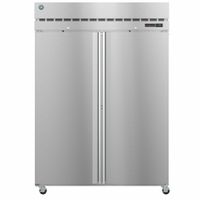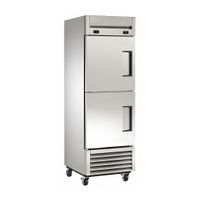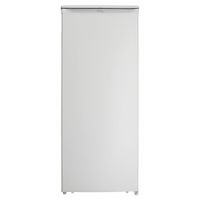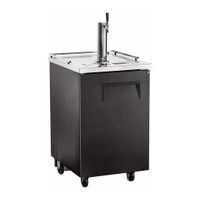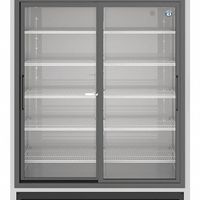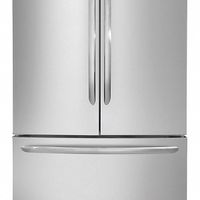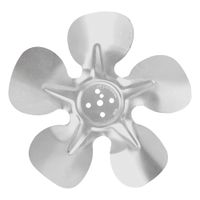Call +(254) 703 030 000 / 751 483 999 / 721 704 777
- Home
- Furnishings Appliances Hospitality
- Appliances
- Refrigerators Freezers
Frequently Asked Questions
What is the difference between a refrigerator and a freezer?
A refrigerator and a freezer are both appliances designed to preserve food by maintaining low temperatures, but they serve different purposes and operate at different temperature ranges.
A refrigerator is primarily used to keep food and beverages cool, typically maintaining a temperature range between 35°F to 40°F (1.7°C to 4.4°C). This temperature range is ideal for slowing down the growth of bacteria and mold, thereby extending the shelf life of perishable items like fruits, vegetables, dairy products, and leftovers. Refrigerators often have multiple compartments, including crisper drawers for produce and door shelves for condiments, to organize various types of food efficiently.
In contrast, a freezer is designed to store food at much lower temperatures, usually at or below 0°F (-18°C). This temperature is crucial for freezing food, which halts bacterial growth and preserves food for much longer periods compared to refrigeration. Freezers are ideal for storing meats, frozen vegetables, ice cream, and other items that require long-term storage. They can be standalone units or part of a refrigerator-freezer combination, with the freezer compartment typically located either above or below the refrigerator section.
The key differences between the two appliances lie in their temperature settings and intended use. Refrigerators are for short-term storage and cooling, while freezers are for long-term storage and freezing. Additionally, the design and layout of each appliance reflect their specific functions, with freezers often having more robust insulation to maintain the lower temperatures required for freezing.
How do commercial refrigerators differ from standard refrigerators?
Commercial refrigerators differ from standard refrigerators in several key aspects:
1. **Capacity and Size**: Commercial refrigerators are designed to store large quantities of food and beverages, making them significantly larger than standard residential models. They often have more shelves and compartments to accommodate bulk storage.
2. **Cooling Power**: These units have more powerful compressors and cooling systems to maintain consistent temperatures, even with frequent door openings. This ensures food safety and freshness in high-demand environments.
3. **Durability and Construction**: Built with heavy-duty materials like stainless steel, commercial refrigerators are designed to withstand the rigors of a busy kitchen. They are more robust and resistant to wear and tear compared to standard models.
4. **Energy Efficiency**: While both types aim for energy efficiency, commercial refrigerators often have more advanced insulation and energy-saving features to handle the demands of continuous operation.
5. **Temperature Control**: Commercial units offer precise temperature controls and often have multiple zones for different types of food storage, which is crucial for maintaining health standards in food service.
6. **Design and Accessibility**: These refrigerators are designed for easy access and quick loading/unloading, with features like self-closing doors and adjustable shelving. They often have glass doors for visibility, which is less common in residential models.
7. **Compliance and Safety**: Commercial refrigerators must meet specific health and safety regulations, including NSF certification, to ensure they are suitable for food service environments.
8. **Cost**: Due to their advanced features and durability, commercial refrigerators are generally more expensive than standard residential models.
9. **Noise Level**: They tend to be noisier due to their powerful compressors, which is less of a concern in commercial settings compared to home environments.
What are the benefits of using a standalone freezer?
A standalone freezer offers several benefits that can enhance both convenience and efficiency in food storage. Firstly, it provides additional storage space, allowing households to buy in bulk and store large quantities of food, which can lead to cost savings and reduced frequency of shopping trips. This is particularly beneficial for families or individuals who prefer to stock up on seasonal produce or take advantage of sales.
Secondly, standalone freezers often have more efficient cooling systems compared to the freezer compartments in standard refrigerators. This can result in better preservation of food quality, as the consistent temperature helps prevent freezer burn and maintains the nutritional value of stored items.
Another advantage is the organizational flexibility. Standalone freezers typically come with adjustable shelves, baskets, and compartments, making it easier to categorize and access different types of food. This organization can reduce food waste by ensuring that items are easily visible and less likely to be forgotten.
Energy efficiency is another benefit, as many modern standalone freezers are designed to consume less electricity, which can lead to lower utility bills. Additionally, having a separate freezer allows the main refrigerator to operate more efficiently, as it is not overburdened with excess frozen goods.
Standalone freezers also offer versatility in placement. They can be located in basements, garages, or utility rooms, freeing up kitchen space and allowing for a more streamlined kitchen environment.
Lastly, for those who hunt, fish, or garden, a standalone freezer provides the necessary space to store large quantities of meat, fish, or home-grown produce, ensuring that these items remain fresh and available year-round. Overall, a standalone freezer is a practical investment for those seeking to optimize food storage and management.
How do refrigerated merchandisers and display cases work?
Refrigerated merchandisers and display cases are designed to keep perishable products at optimal temperatures while showcasing them to customers. They work through a combination of refrigeration technology and strategic design.
At the core, these units use a refrigeration cycle involving a refrigerant, which absorbs heat from the interior and expels it outside. The cycle begins with the compressor, which compresses the refrigerant, raising its temperature and pressure. The hot, high-pressure gas then moves to the condenser coils, usually located at the back or bottom of the unit, where it releases heat and condenses into a liquid.
The liquid refrigerant then passes through an expansion valve, which reduces its pressure, causing it to cool rapidly. This cold refrigerant flows through the evaporator coils inside the display case. As air circulates over these coils, it cools down, maintaining the desired temperature within the case. Fans help distribute this cold air evenly throughout the unit.
The design of refrigerated merchandisers often includes glass doors or open fronts to allow customers to view products easily. LED lighting is commonly used to enhance visibility and reduce heat emission. Shelving is adjustable to accommodate various product sizes and maximize display space.
Temperature controls and sensors ensure the interior remains at a consistent temperature, crucial for food safety and energy efficiency. Some units also feature defrost cycles to prevent ice buildup on the evaporator coils, which can impede performance.
Overall, refrigerated merchandisers and display cases combine efficient cooling systems with customer-friendly design to preserve product quality while enhancing retail presentation.
What is a kegerator and how does it function?
A kegerator is a specialized refrigerator designed to store and dispense kegs of beer, keeping them fresh and at an optimal serving temperature. It combines the words "keg" and "refrigerator." Kegerators are popular in both commercial settings, like bars and restaurants, and residential settings for home brewers or beer enthusiasts.
Functionally, a kegerator consists of several key components:
1. **Refrigeration Unit**: This is the main body of the kegerator, which houses the keg and maintains a consistent temperature, typically between 36-40°F (2-4°C), to ensure the beer remains fresh and carbonated.
2. **Keg**: The container that holds the beer. Kegs come in various sizes, with the most common being the half-barrel, which holds about 15.5 gallons (58.67 liters) of beer.
3. **CO2 Tank and Regulator**: The CO2 tank provides the pressure needed to push the beer from the keg to the tap. The regulator controls the amount of pressure applied, which is crucial for maintaining the beer's carbonation and ensuring a smooth pour.
4. **Beer Lines and Coupler**: The beer lines connect the keg to the tap. The coupler is a device that attaches to the keg valve, allowing the CO2 to enter the keg and the beer to flow out.
5. **Tap and Faucet**: The tap, or faucet, is the dispensing mechanism. When opened, it allows the beer to flow from the keg through the lines and into a glass.
By maintaining the right temperature and pressure, a kegerator ensures that beer is served fresh, with the correct level of carbonation, and without exposure to air, which can cause spoilage.
How do you maintain and clean commercial refrigeration units?
To maintain and clean commercial refrigeration units, follow these steps:
1. **Regular Inspection**: Check for any signs of wear, leaks, or unusual noises. Ensure door seals are intact to maintain efficiency.
2. **Cleaning Coils**: Clean condenser and evaporator coils every three months. Use a coil brush or vacuum to remove dust and debris, ensuring efficient heat exchange.
3. **Check Refrigerant Levels**: Ensure refrigerant levels are optimal. Low levels can indicate leaks and reduce cooling efficiency.
4. **Clean Interior and Exterior**: Wipe down the interior and exterior surfaces with a mild detergent and warm water. Avoid harsh chemicals that can damage surfaces.
5. **Defrosting**: Regularly defrost units to prevent ice build-up, which can hinder performance. Follow manufacturer guidelines for defrosting procedures.
6. **Drain Line Maintenance**: Clear drain lines to prevent clogs and water overflow. Use a mixture of warm water and vinegar to flush the lines.
7. **Fan and Motor Maintenance**: Inspect and clean fans and motors to ensure they are free of dust and debris. Lubricate moving parts as needed.
8. **Temperature Monitoring**: Regularly check and calibrate temperature settings to ensure they are within the recommended range for food safety.
9. **Door Gasket Inspection**: Inspect door gaskets for cracks or wear. Replace if necessary to maintain an airtight seal.
10. **Professional Servicing**: Schedule annual professional maintenance to address complex issues and ensure the unit operates efficiently.
By adhering to these maintenance and cleaning practices, commercial refrigeration units can operate efficiently, prolonging their lifespan and ensuring food safety.
What are the energy efficiency considerations for commercial refrigeration appliances?
Energy efficiency in commercial refrigeration appliances is crucial for reducing operational costs and environmental impact. Key considerations include:
1. **Insulation Quality**: High-quality insulation minimizes heat exchange, reducing the energy needed to maintain desired temperatures.
2. **Compressor Efficiency**: Modern, variable-speed compressors adjust their operation based on demand, using less energy compared to traditional models.
3. **Refrigerant Type**: Using low-GWP (Global Warming Potential) refrigerants can improve efficiency and reduce environmental impact.
4. **Heat Recovery Systems**: These systems capture waste heat from the refrigeration process for other uses, such as heating water, improving overall energy efficiency.
5. **Evaporator and Condenser Design**: Efficient heat exchangers with optimized airflow and surface area enhance heat transfer, reducing energy consumption.
6. **Defrost Systems**: Adaptive or demand defrost systems activate only when necessary, saving energy compared to time-based systems.
7. **Lighting**: LED lighting consumes less energy and generates less heat than traditional lighting, reducing the cooling load.
8. **Door Design and Usage**: Self-closing doors, air curtains, and proper seals prevent cold air loss, maintaining efficiency.
9. **Temperature Control Systems**: Advanced thermostats and sensors ensure precise temperature maintenance, avoiding overcooling.
10. **Regular Maintenance**: Routine cleaning and servicing of components like coils and fans ensure optimal performance and efficiency.
11. **Energy Management Systems**: These systems monitor and optimize energy use across multiple units, identifying inefficiencies and opportunities for savings.
12. **Load Management**: Proper stocking and organization reduce the cooling load and improve airflow within the unit.
By focusing on these considerations, businesses can significantly reduce energy consumption, lower costs, and minimize their carbon footprint.
